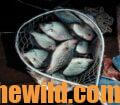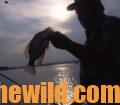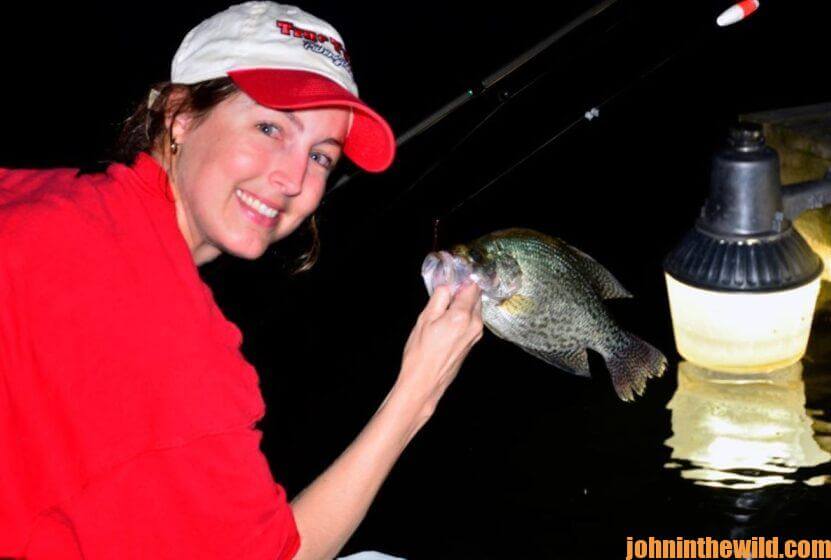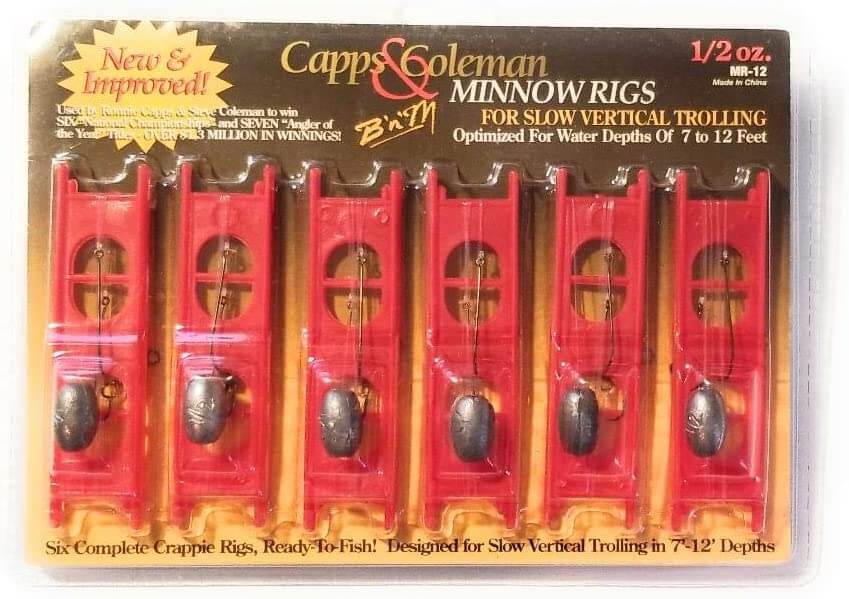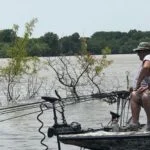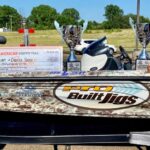Editor’s Note: Nighttime crappie fishing is one of the most addictive forms of fishing I know. Crappie fishing at night in the summer is cool, relaxing, rewarding, and an ideal way to spend quality time with friends and family away from the rest of the world. Also, crappie fishing at night doesn’t interfere with any of my daytime activities. I can fish in the afternoons after work, fish all night Friday and Saturday, and still have Sunday after church to recover.
“The biggest problem with fishing for crappie during the hot summer months is keeping your minnows alive and lively,” a friend mentioned before we fished for crappie. “Because the water’s so hot, an aerator is a must.”
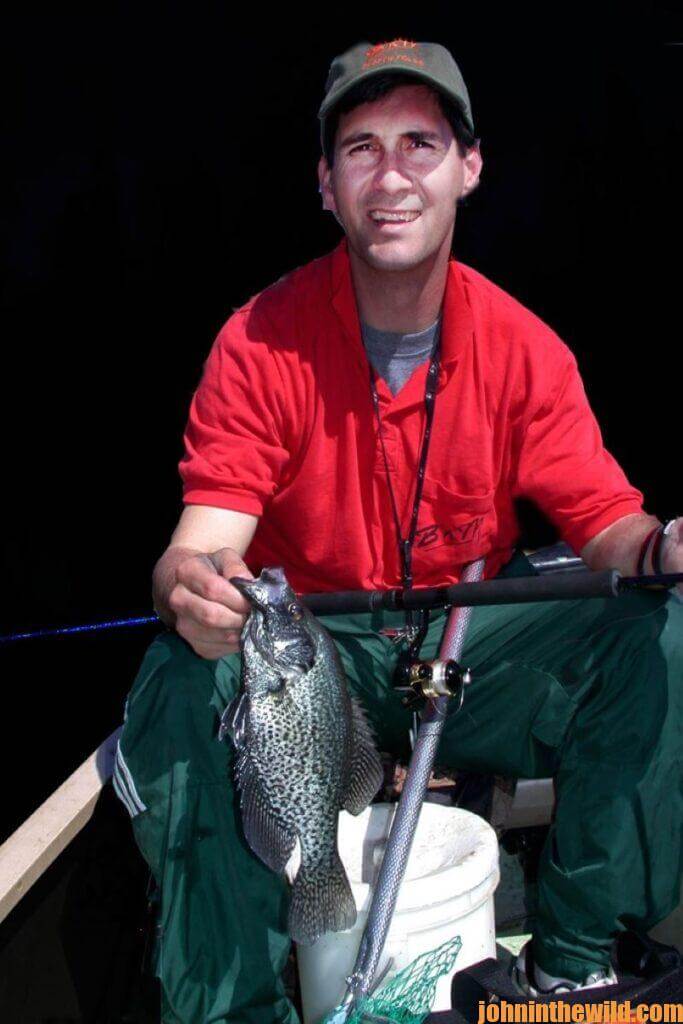
Aeration alone won’t keep minnows from dying. Many anglers fill plastic medicine bottles 3/4 of the way to the top with water, screw the lids tight on the bottles, and put the bottles in the freezer.
After freezing, they’ll use one in each minnow bucket to keep the fish cool and the minerals in the water from killing the minnows.
I like either a lightweight or ultralight crappie rod. After putting a small weight on the end of the line, I then fish with a crappie rig that consists of two drop lines coming off the main line – a B‘n’M Capps and Coleman Minnow Rig. I usually fish with a 4-6-pound test line.
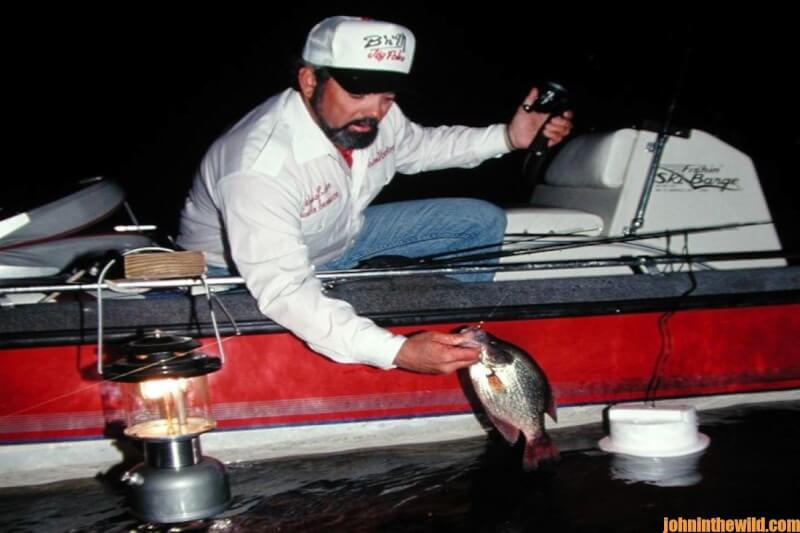
I’ll rig with a crappie hook, a small shot lead, and a quill cork and set the cork on the outside edges of the light and fish several rods since in many states you can fish at one time with numerous rods and poles for crappie. Some lakes in a state may have restrictions on fishing more than one rod or pole.
Be sure to check the state’s crappie regulations where you’re fishing. My fishing companions generally will have the same number of lines down that I do.
Many crappiers use lanterns, either floating lights that shine beams down deep toward the bottom or a lantern that draws in bugs and causes the bugs to fall into the water. I like both kinds of lights.
For night crappie, I bait with live, large, shiner minnows. Generally, the bigger the minnows I fish with, the larger the crappie I’ll catch. However, I also carry at least a dozen, 1/24- and 1/32-ounce jigs with me to always have bait to fish. My depth finder gets a workout at night pinpointing crappie on underwater creeks, river ledges, and drop-offs.
Recommended Crappie Fishing Gear: B‘n’M Capps and Coleman Minnow Rig
About the B‘n’M Capps and Coleman Minnow Rig
The BnM Capps and Coleman Minnow Rigs 0.5 oz are precision tied for the best balance to minimize line twists and create a near-perfect live bait presentation. Each rig is created for your exact need to catch crappie at any depth or trolling speed throughout the year. The Eagle Claw #2 Type 214 EL hooks, 2 on each rig, will minimize lost fish and lost rigs from snagging. Choose your rig based on the depth you desire to fish, tie to your line, and you’re ready to go.
These rigs will save you time and energy, approx 15 minutes each, and will allow you to keep your minnows in the water to catch more crappie. The directions on the back will tell you everything you need to know. It is a great rig for casting and retrieving slowly under a slip bobber.
- Precision tied for the best balance
- Minimizes line twist
- Creates a near-perfect live bait presentation
- Created for your exact need to catch crappie at any depth or trolling speed throughout the year
- Two Eagle Claw #2 Type 214 EL hooks on each rig
Promising Amazon Review: “Great product for catching crappie.” ~ Anita
Tomorrow: Where to Fish for Nighttime Crappie
Affiliate Disclosure: JohnInTheWild.com is reader-supported. If you purchase anything we mention using our referral links, we may get a small commission. However, there’s no extra cost to you. Thanks for supporting John E. Phillips’ Outdoor Journals!
When you use the links below to go to Amazon, notice on the left of the Audible option where Amazon says you can hear a sample that gives you 10% of these books for free! On the right side of the page for each book and below the offer for a free Audible trial, you can choose to Buy the Audible book.
Be sure to also check out John’s Free Books as our gift to you!
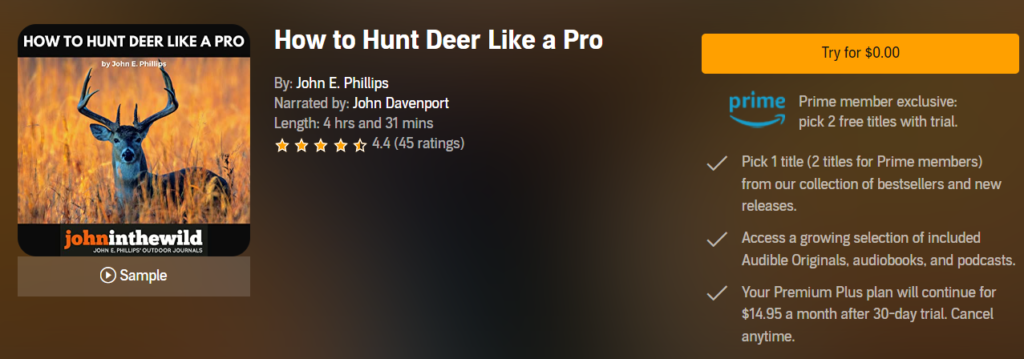
Prime Members: You’re eligible to claim 2 free titles with your 30-day Audible Premium Plus trial! Browse more than 100 of John E. Phillips’ expert guidebooks on hunting and fishing here.
Books By Topic
Category Shortcuts: View on Amazon
| Deer Hunting | Turkey Hunting | Elk Hunting | Bass Fishing |
| Mule Deer Hunting | Bowhunting | Bowfishing | Crappie Fishing |
| All Cookbooks | Hunting Cookbooks | Fishing Cookbooks | All Audible Books |
Expert Guidebooks on Crappie Fishing: Best Sellers
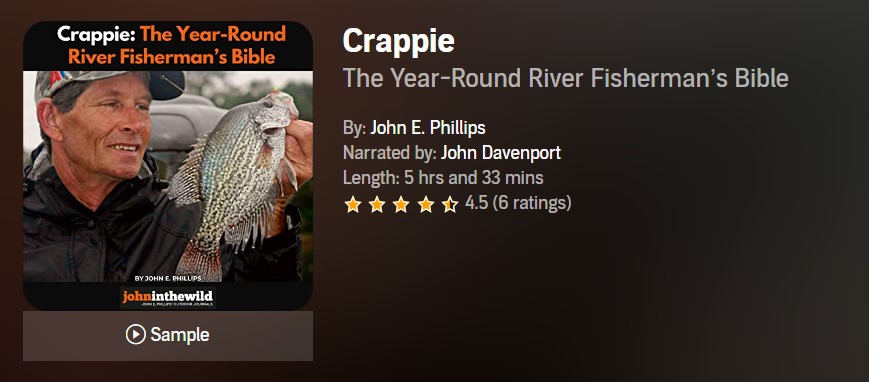
Fishing rivers for crappie and being able to find and catch speckled sides consistently has long been one of the mysteries in the crappie-fishing world.
“One of the reasons that river systems are so difficult to fish is because the water’s either rising or falling in them,” says Ott DeFoe, the 2019 Bassmaster Classic champion.
Rivers also are very susceptible to floods and droughts and constantly have current moving through them. Often fast current or slow current in rivers is created by rain or droughts upstream. When rivers flood, they can wash away fish habitat like logs, sunken trees, manmade brush piles and stake beds. But that’s the time when a river also creates new crappie hot spots that haven’t been available to the crappie or the fishermen before the flood.
Because river systems are so unpredictable, I’ve felt the best way to get the most useful information on how to fish rivers for crappie is to talk to numbers of anglers all over the nation to learn their best tactics.
In this book, I’ve gleaned crappie-fishing wisdom from three dozen crappie anglers and guides from a dozen states, who consistently catch crappie at all times of the year. The tournament crappie fishermen in this book fish most of the country at different times of the year on various river systems and lakes. And, these anglers use techniques you never may have considered, including:
- Setting up a casting ring with your electronics to keep you from getting too close to the crappie that are holding on underwater structure, while you’re fishing all the way around the structure;
- Buying an automotive laser temperature gauge to measure water temperature
- Evaluating the most-productive places to sink brush and other structure, according to prevailing wind direction, the crappie’s summer, fall, winter, and spring migration patterns, and other factors.
VERSIONS: AUDIBLE, KINDLE & PRINT
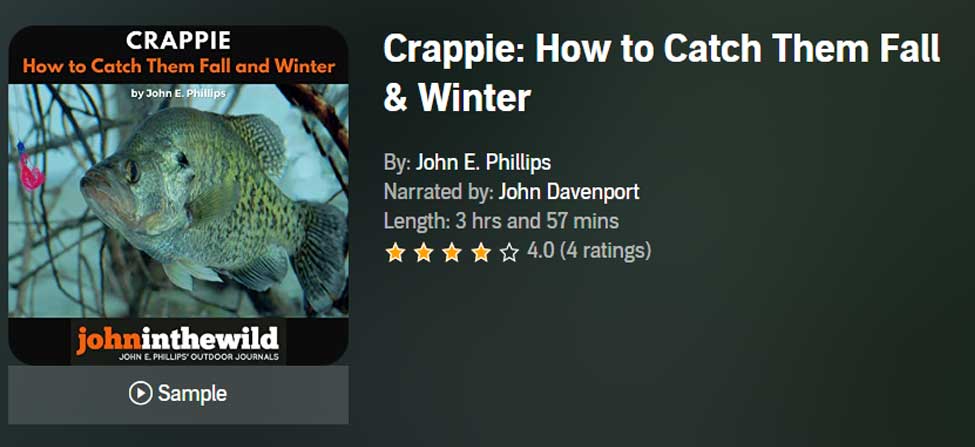
Crappie: How to Catch Them Fall & Winter
Yes, you can catch and eat crappie during the fall and winter months. Often, at many places, you’ll catch more and bigger crappies in the fall and winter than you do in the spring and summer. To learn where to find and how to catch cooler weather speckled sides, we’ve interviewed a wide variety of some of the nation’s best tournament crappie fishermen and guides.
Many of the individuals you’ll hear about in this audiobook are tournament crappie pros who travel the country to fish in crappie tournaments from New York to Florida and from Virginia to California. They use the latest crappie-finding equipment, the best poles, rods, reels, line, and the most-productive baits. Each of the people mentioned in this book has the ability to be dropped out of an airplane anywhere in the United States and catch crappie on any lake close to where they land that contains crappie.
From over 50 years of crappie-fishing experience, I’ve learned that you get the best advice by interviewing a large number of people who have different tactics and fish under various water, weather, and fishing-pressure conditions.
In this book, you will learn:
- How to spider-rig (slow-troll), which is one of the fastest-growing techniques for catching the most and biggest crappies in the shortest time
- How to catch crappie on crank baits and when and where using a crank bait is the most appropriate
- How to find areas of any lake that will hold large schools of crappies during the winter months – places you can return to time and again and expect them to be there
- Why competing in crappie tournaments is one of the quickest ways to learn how to catch more and bigger crappie faster
- Why and how to look for and catch the biggest crappie in a lake
VERSIONS: AUDIBLE, KINDLE & PRINT
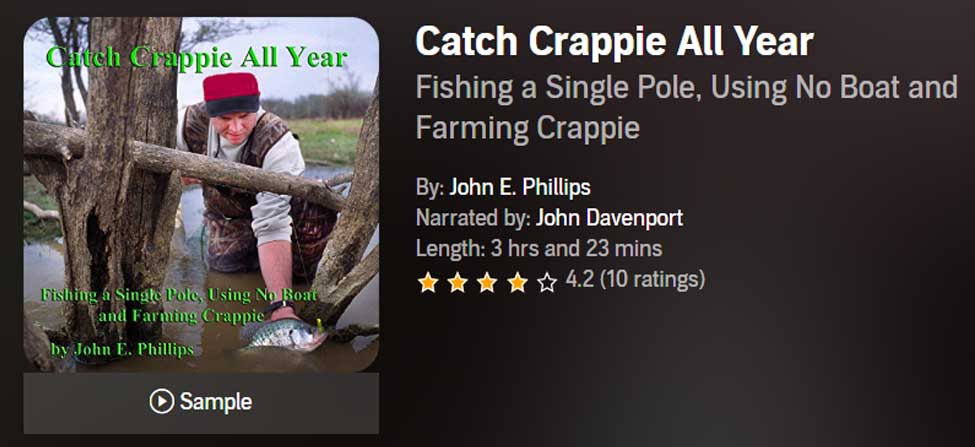
Catch Crappie All Year: Fishing a Single Pole, Using No Boat, and Farming Crappie
I’ve interviewed some of the best crappie fishermen in the nation for my new audiobook, Catch Crappie All Year: Fishing a Single Pole, Using No Boat and Farming Crappie to learn how, where, and when to catch the most crappie with or without a boat while single-pole fishing. I’ve also included information on how to grow a crop of crappie to catch every day of the year. Although I’ve fished in fully rigged crappie boats costing $45,000 – $90,000-plus that can have up to 16 rods at one time to slow troll, I still enjoy….
- Watching a quill cork sink in a brush top
- Fishing with an ultralight spinning rod
- Reeling jigs or minnows along a grass line and feeling that thud when a crappie takes the bait
- Fishing with family and friends, even if we all can’t fit in one boat
- Participating in less-expensive and hassle-free yet highly-productive crappie fishing like single poling
I’ve tried to capture in this new audiobook the old way of crappie fishing with new twists and detailed tactics to aid you in catching crappie all year.
VERSIONS: AUDIBLE, KINDLE & PRINT
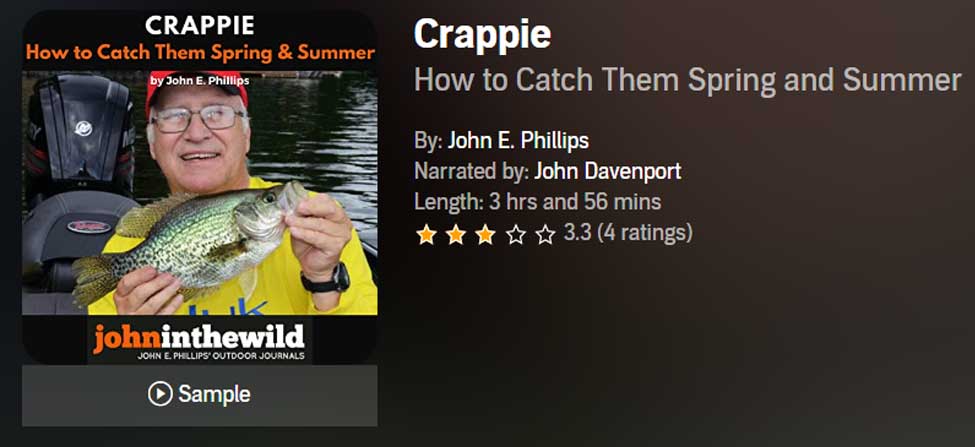
Crappie: How to Catch Them Spring and Summer
You can catch crappie all year long if you know where to find them and what techniques to use to catch them. However, crappie fishing is so technical these days, and we’ve learned so much about how to crappie fish because of the professional crappie-fishing circuits, that one book can’t hold all the information.
This book is the first of a three-part series on how, where, and when to catch crappie, with the best crappie fishermen in the nation. Many of these men have proven they are the best, because they’ve won crappie-fishing tournaments or been successful fishing guides for many years.
This audio version of Crappie: How to Catch Them Spring and Summer includes crappie pros like Ronnie Capps, who has won seven national championships and over $1 million with his partner Steve Coleman.
We also have Malcolm Lane, Stokes McClellan from North Carolina, Billy Blakeley from Reelfoot Lake, John Woods, Kent Driscoll, fishing biologist and professional basser Ken Cook, and many others. We asked the questions that crappie fishermen want answered about how to find and catch crappie during the spring and summer months, and these fishing tips are the result.
In the world of crappie fishing, no one man knows it all, and that’s why I’ve interviewed so many fishermen, asked so many questions, and tried to get so many answers for you about how to fish.
VERSIONS: AUDIBLE, KINDLE & PRINT

